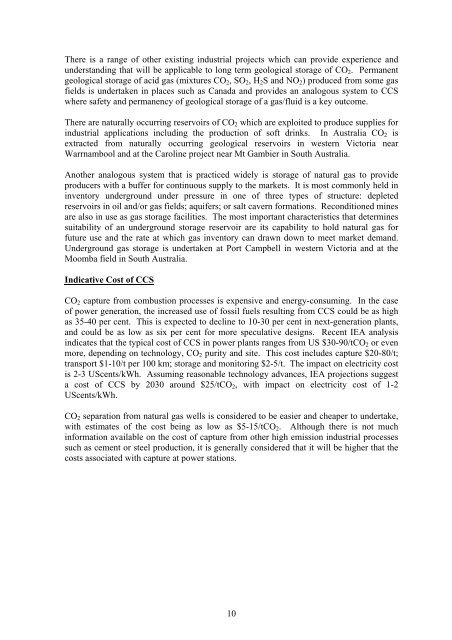Environmental Guidelines for Carbon Dioxide Capture and ...
Environmental Guidelines for Carbon Dioxide Capture and ...
Environmental Guidelines for Carbon Dioxide Capture and ...
You also want an ePaper? Increase the reach of your titles
YUMPU automatically turns print PDFs into web optimized ePapers that Google loves.
There is a range of other existing industrial projects which can provide experience <strong>and</strong>underst<strong>and</strong>ing that will be applicable to long term geological storage of CO 2 . Permanentgeological storage of acid gas (mixtures CO 2 , SO 2 , H 2 S <strong>and</strong> NO 2 ) produced from some gasfields is undertaken in places such as Canada <strong>and</strong> provides an analogous system to CCSwhere safety <strong>and</strong> permanency of geological storage of a gas/fluid is a key outcome.There are naturally occurring reservoirs of CO 2 which are exploited to produce supplies <strong>for</strong>industrial applications including the production of soft drinks. In Australia CO 2 isextracted from naturally occurring geological reservoirs in western Victoria nearWarrnambool <strong>and</strong> at the Caroline project near Mt Gambier in South Australia.Another analogous system that is practiced widely is storage of natural gas to provideproducers with a buffer <strong>for</strong> continuous supply to the markets. It is most commonly held ininventory underground under pressure in one of three types of structure: depletedreservoirs in oil <strong>and</strong>/or gas fields; aquifers; or salt cavern <strong>for</strong>mations. Reconditioned minesare also in use as gas storage facilities. The most important characteristics that determinessuitability of an underground storage reservoir are its capability to hold natural gas <strong>for</strong>future use <strong>and</strong> the rate at which gas inventory can drawn down to meet market dem<strong>and</strong>.Underground gas storage is undertaken at Port Campbell in western Victoria <strong>and</strong> at theMoomba field in South Australia.Indicative Cost of CCSCO 2 capture from combustion processes is expensive <strong>and</strong> energy-consuming. In the caseof power generation, the increased use of fossil fuels resulting from CCS could be as highas 35-40 per cent. This is expected to decline to 10-30 per cent in next-generation plants,<strong>and</strong> could be as low as six per cent <strong>for</strong> more speculative designs. Recent IEA analysisindicates that the typical cost of CCS in power plants ranges from US $30-90/tCO 2 or evenmore, depending on technology, CO 2 purity <strong>and</strong> site. This cost includes capture $20-80/t;transport $1-10/t per 100 km; storage <strong>and</strong> monitoring $2-5/t. The impact on electricity costis 2-3 UScents/kWh. Assuming reasonable technology advances, IEA projections suggesta cost of CCS by 2030 around $25/tCO 2 , with impact on electricity cost of 1-2UScents/kWh.CO 2 separation from natural gas wells is considered to be easier <strong>and</strong> cheaper to undertake,with estimates of the cost being as low as $5-15/tCO 2 . Although there is not muchin<strong>for</strong>mation available on the cost of capture from other high emission industrial processessuch as cement or steel production, it is generally considered that it will be higher that thecosts associated with capture at power stations.10
















